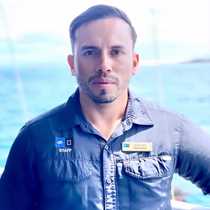Isabela & Fernandina
Our expeditions led us this time to the western side of the enchanted archipelago. After breakfast we went up to the bow of the National Geographic Islander to cross the equator line towards the southern hemisphere. The scenery of the coastline of Isabela was certainly outstanding, with many volcanoes standing along the young lava flows which were filling some collapse calderas and craters.
We anchored at Punta Vicente Roca, at the northern snout of the sea horse shaped island. Our guests went out on a Zodiac ride along the coast in search for Galapagos penguins, Nazca boobies, Galapagos fur sea lions, and flightless cormorants. And without expecting them, out of the deep water a school of cow-nosed golden rays came to greet us! Soon we rode our Zodiacs out to deeper waters to look for the ocean sun fish (the largest bone fish on our planet) and we certainly found several of them swimming on the surface trying to feed on sea jellies. We couldn’t resist getting into the productive ocean water of Punta Vicente Roca, so we went snorkeling with turtles, cormorants, sea lions and plenty of fish which were all swimming around us. Some of the cormorants were very curious, coming very close to explore our equipment and take a closer look at us.
During the afternoon we had a dry landing on the youngest island of the Galapagos, Fernandina Island, the most preserved of the enchanted archipelago. As soon as we stepped on this visitor site, we traveled in time to millions of years ago, and got a better perspective of how the islands used to be, without introduced species and with the absence of human impact. The mother volcano of the island has erupted several times in the last 159 years, and in fact it is one of the most active volcanoes in the world. But here species have adapted to the rustiness and pristine conditions that the young lava flows and sandy areas offer as habitat. Hundreds of the largest Galapagos marine iguanas were basking in piles of digesting individuals under the sun. Sally lightfoot crabs were delighted by the algae that washed up on shore after the high tide and small harems of sea lions had taken possession of the sand under the mangroves. But the highlight this afternoon was definitely hundreds of female marine iguanas digging up their nests on the white coralline sand, preparing them to lay eggs for the season.




